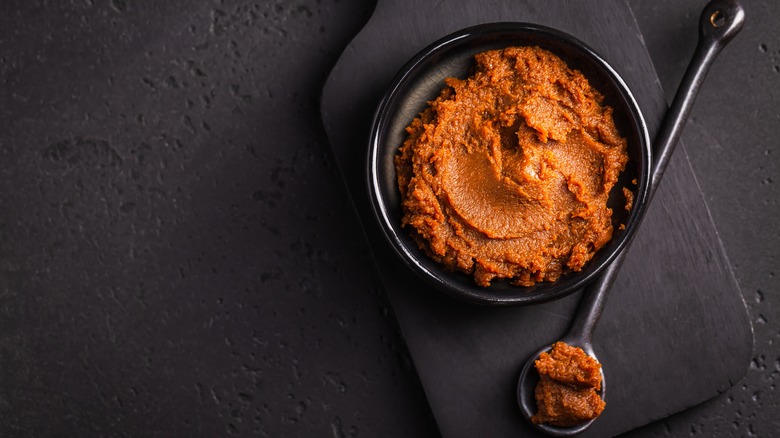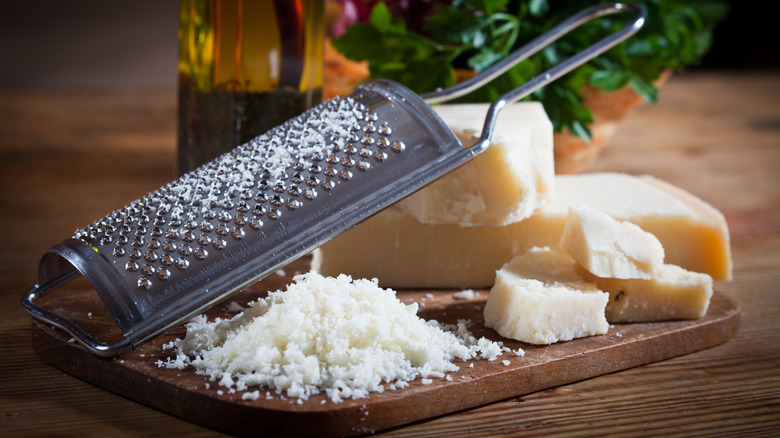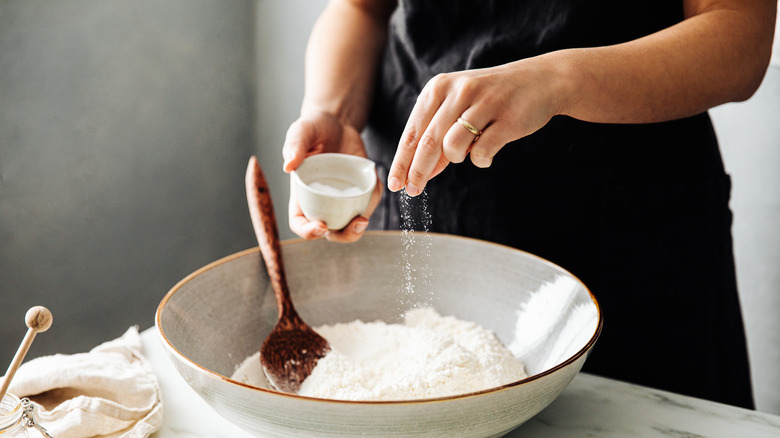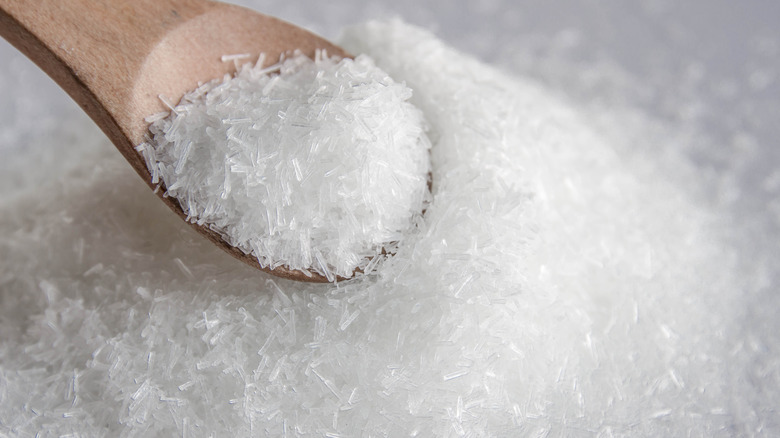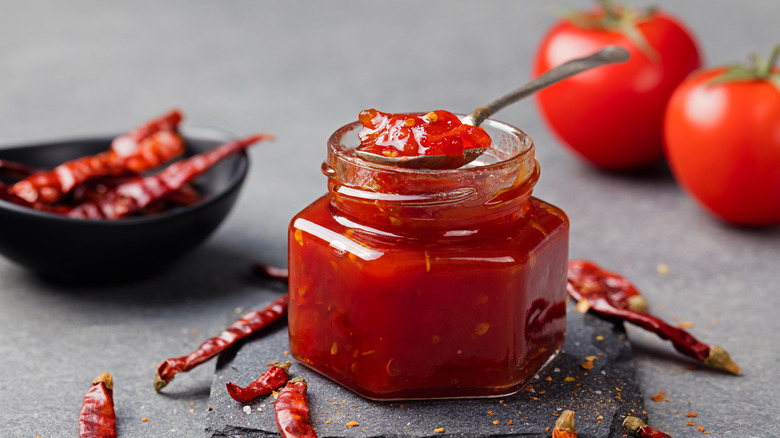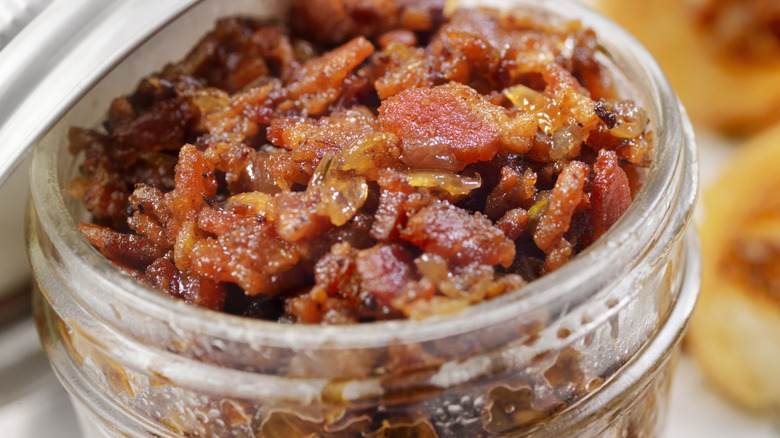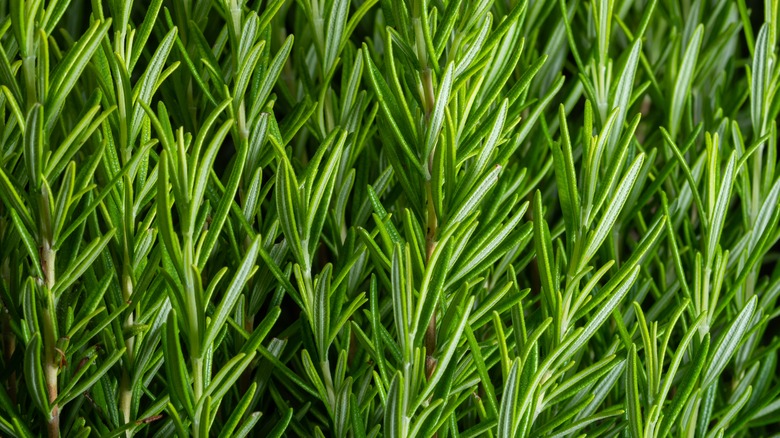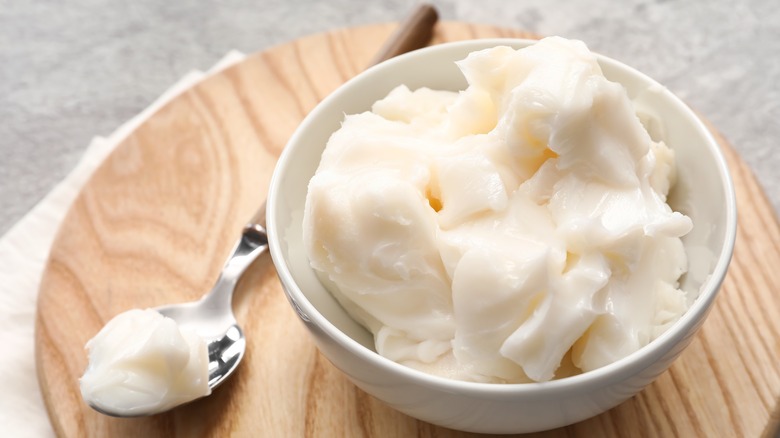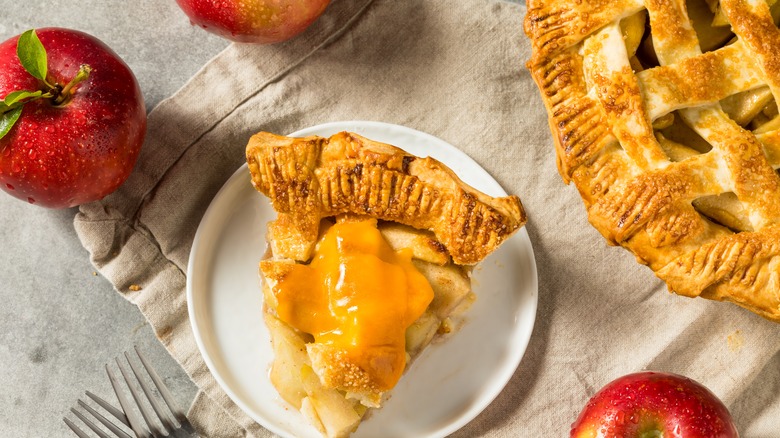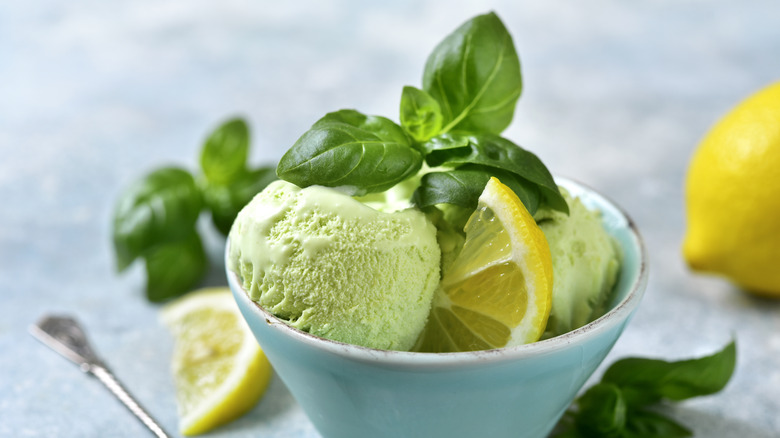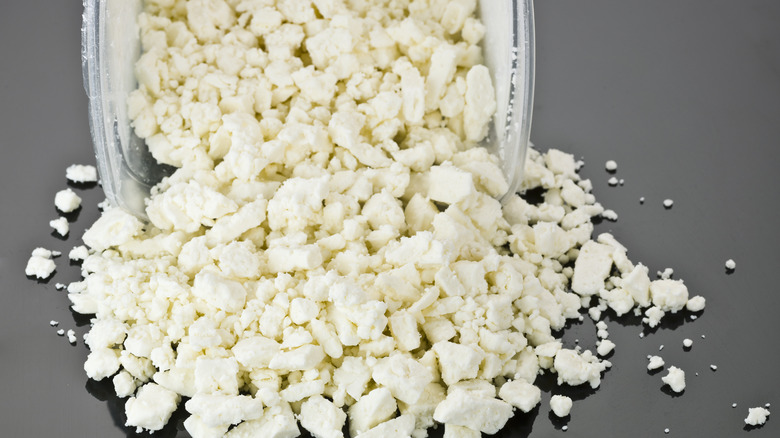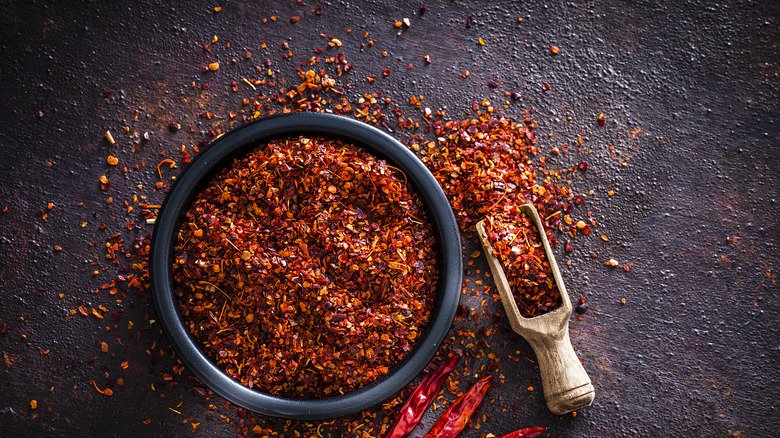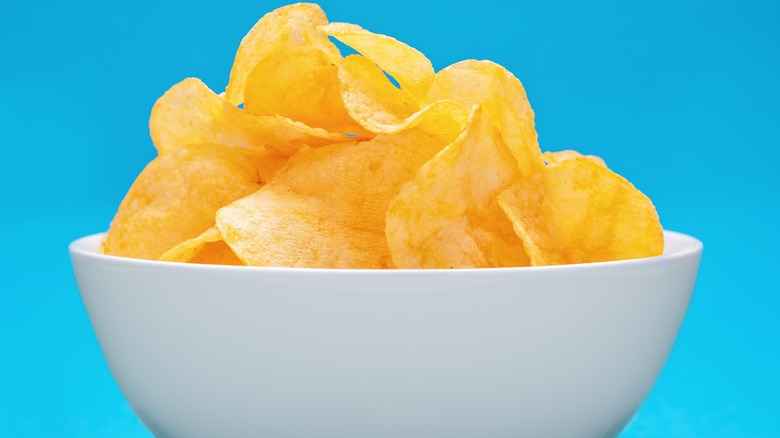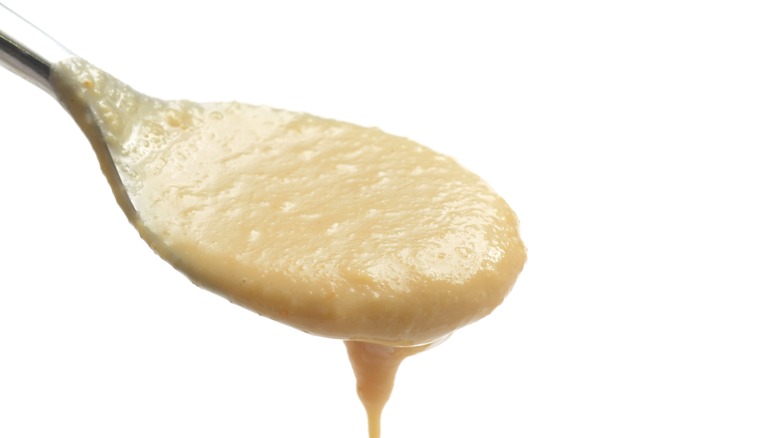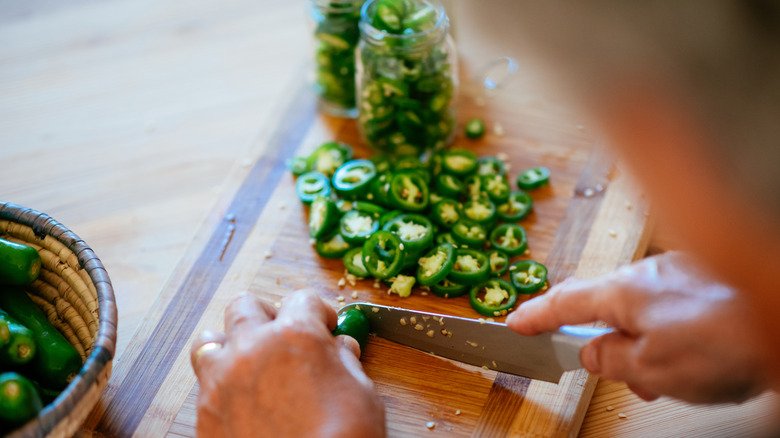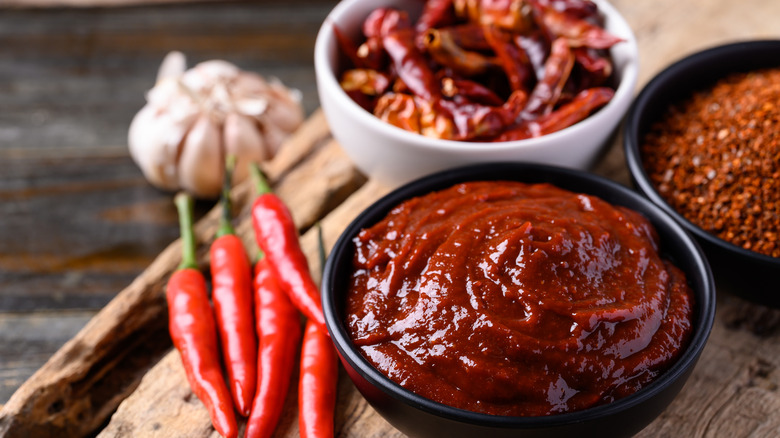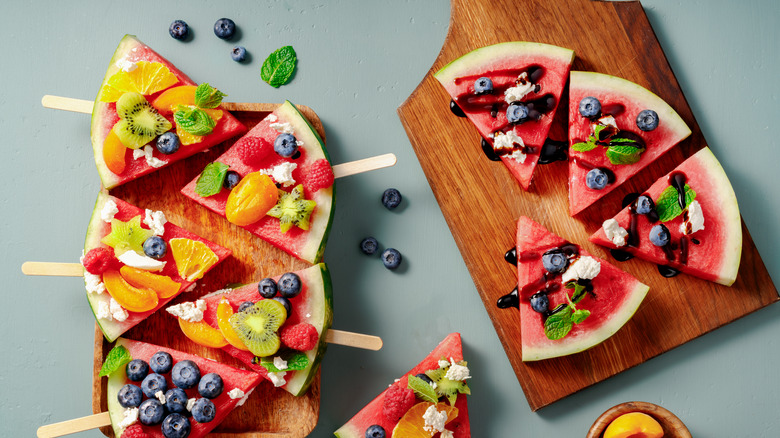20 Best Savory Ingredients To Elevate Desserts
The proliferation of savory ingredients has transformed modern baking. And no, we're not talking about savory bakes – like mindblowing quiches mixed with fresh vegetables and mushroom galettes with delicate, flaky crusts. This is about the use of traditionally salty, spicy, and even umami ingredients making their way into cookie recipes and on top of ice creams.
Why would you ever want to add fish sauce to sorbet or cheddar cheese to an apple pie? Well, these unique ingredients help round out the flavors of the recipe and introduce new complexities that aren't purely sweet. And although we're not saying there's anything wrong with a good chocolate chip cookie, it's a little more enjoyable to eat when it doesn't make your teeth hurt.
Here are some of our favorite unconventional ingredients to add to desserts to help make the flavors a bit more grown-up. Since these ingredients can be overpowering in one dimension or another, we recommend measuring everything out deliberately and, of course, tasting as you go.
Fish sauce
Fish sauce is an ingredient you probably reserve exclusively for stir fry. But it's also the savory ingredient Andrea Nguyen adds to chocolate sorbet. This condiment, made with fermented, salted anchovies, adds a unique umami funk to the sweetness of the sorbet. It has a bit of tang, too, which curbs some of the bitterness from the chocolate.
Nguyen was inspired to add the Asian condiment to her recipe by a chocolate truffle with fish sauce dish she ate at the Culinary Institute of America Worlds of Flavor conference. She substituted some of the sea salt for fish sauce in her sorbet and discovered this flavorful combination. The chef also adds a bit of heat to her recipe by drizzling it with chili oil before serving.
Miso paste
Miso paste is finally getting the time in the spotlight that it has long deserved. Crystelle Pereria notably made many miso-based desserts on "The Great British Baking Show," including her white chocolate chouxnuts, miso, pecan and caramel apple tart, and her miso and tahini frappuccino ice cream sandwich. But there's so much more to miso than just reality television.
You should consider adding miso to baked goods for a subtle flavor boost. It brings a subtle, umami element to cookies, cakes, and everything. Use two tablespoons of miso paste for each cup of flour in the recipe, and decrease (or omit) the salt to avoid making a dessert too salty. You should also mix the paste into liquid before adding it to the dry ingredients to prevent any unforeseen grittiness.
Parmesan cheese
Parmesan is a mild, umami ingredient that is incredibly useful for adding flavor to desserts. One of our favorite ways to use this salty, umami-rich cheese is for cheesecake. The nuttiness of the cheese also pairs well with the soft cream cheese and optional sour cream, making for an uber-rich, cheesy recipe. Since Parmesan cheese tends to get gritty when it's added to recipes, it's best to use a microplane to grate the cheese to the smallest particle size possible. A relatively young cheese is ideal for the recipe because it's creamier than one aged for over two years.
Add the Parmesan to the graham cracker crust and the cheese filling for optimal cheesiness. We also recommend adding crushed pecans to the graham cracker crust to amp up the fatty undertone.
Thyme
Thyme is the perfect herbal ingredient to add to savory recipes. It has a mild organic undertone that boosts the profile of citrus, vanilla, and other spices. Try adding fresh-from-the-garden flavors to your lemon-thyme bars. Not only are there fresh thyme leaves crumbled up in the crust, but the curd is also steeped with several sprigs. It's the perfect dessert for a springtime celebration.
Thyme also sparkles in a cookie recipe. Chef Anna Gordon elevates her cookies by rolling them in ground thyme and coarse sugar and then baking them. It adds herbaceous flavor and sweetness to the recipe. We recommend adding fresh thyme to the recipe rather than dried herbs because it tends to have a fresher flavor that helps lighten up a buttery recipe, like cookies or a pie crust.
Sea salt
Sea salt is an easy way for anyone to dip their toes into savory baking — without getting too crazy. It's an ingredient you can use to elevate cookies and make the flavor more complex. One of our favorite recipes is for fleur de sel chocolate cookies. The flaked salt balances out the bitterness and richness of the high-cacao Valrhona chocolate. It will not only make your recipe more complex, but it will draw the sweetness and the other flavors to the tip of your tongue.
You can also make a homemade salted caramel sauce for drizzling on ice cream, cookies, or brownies. The saltiness of the sea salt flakes brings out the butteriness of the sauce and makes a more well-rounded dessert.
MSG
Mono-sodium glutamate, or MSG, has been demonized by the media for its potential risks to human health. However, research has shown that MSG is not bad for you, and the Food and Drug Administration generally recognizes it as safe. The powder has numerous benefits in the kitchen, including amplifying the savoriness of pizza, stir fry — and even sweet treats.
MSG is an unexpected secret ingredient to adding umami depth to desserts. When working with this ingredient, the best thing to do is find what pairs well with its umami flavor. For example, walnuts are sources of glutamate and would be enhanced with a sprinkle of the powder. It also pairs well with malted ingredients, which stretches into the realm of brownies and cookies.
You can experiment with the power of MSG by adding a half-teaspoon to your favorite sweet recipe and go from there. Too much, and your recipe can come out a tad too fishy.
Tomato jam
Tomato jam is a recipe that screams summertime. This thick sauce is made with flavorful ripe tomatoes, vinegar, spices, and a tad of sugar to mellow out the flavor; it's a perfect accompaniment for a charcuterie board or spread on crispy crackers. But you can also get creative with your tomato jam and use it in a thumbprint cookie recipe for a savory twist.
The base of these cookies is made with semolina and wheat flour dough, which adds a bit of nuttiness to the recipe. Adding a bit of cheese and fresh herbs to the base of the cookie also helps amp up the flavor and turns this into an appetizer, rather than just a cookie that's been led astray.
Bacon
Bacon is the ingredient that makes breakfast better, but nothing is quite like adding crumbled bacon to your dessert recipes, too. You can use up your leftover bacon in a cookie, brownie, or a cupcake. Or, crumble bacon and add it to a milkshake or use it as a savory topping for ice cream. We love pairing it with maple walnut, vanilla, or cookie dough ice cream for a flavorful sundae.
The meat itself isn't the only component to integrate into your recipes. You should stop throwing out bacon grease because you can use it as a fat in your recipes. Instead, cook your bacon slowly to maximize the amount of fat you get from it. Add it to brownies, pie crust, cookies, or cornbread for a butter alternative.
Rosemary
Fresh rosemary is a very mild flavor that can amp up the herby undertone of recipes. Adding rosemary to a shortbread cookie can counteract some of the butteriness of the recipe and make for a bright recipe with a ton of flavor. The flavor of the cookie improves the longer the cookies sit, so try to make this recipe about two days before you actually need it. And since the profile of the herb is very meek, you can use a sugar technique to enhance its flavor. Rub the rosemary sprigs with leaves with granulated sugar to release the essential oils.
If you want a professional-level dessert, try making rosemary cream to go with your cake recipes or poached fruit. The herbaceous undertones of the rosemary provide a light twist to the recipe. You'll also only need two ingredients — heavy cream and rosemary — to make this delicious accompaniment.
Lard
There are a lot of different fats to choose from when it comes to baking. Instead of using the baking staple butter, try to substitute some of it for pork lard. Lard has a mild porky flavor that adds subliminal meatiness to your recipe. There's also a lot that lard can do for your baked foods beyond just adding flavor.
Lard can help your pie crust by adding a tender flake and preventing it from getting as overworked. The lard holds up better to rolling and mixing than other pie crust ingredients, creating a flaky crust perfect for pairing with autumnal apple filling or a decadent chocolate cream pie. You don't want to entirely stop using butter in your pastry, though, because you'll lose some of the sublime flavor and consistency.
Cheddar cheese
Does cheddar cheese belong on apple pie? American culinary history has proven that this staple has been around longer than you'd think and for good reason. Some folks bake their cheese into the filling itself, while others plop a piece on the top of the crust instead. The creaminess of the addition brings a mild, savory flavor without taking away from the sweetness of the apple filling.
You can also use cheddar cheese for other recipes. Adding a mature, medium cheddar with a nutty flavor would be an ideal complement to a cheesecake. You might even find that adding cubes of mild cheddar cheese to your brownies helps add more moisture to your recipe without distracting from the deep chocolate flavor. Fold in the cheddar chunks after your brownie mixture has been made and enjoy your bake with a crisp, cool glass of milk.
Basil
Basil is a deeply underrated ingredient to add to desserts. It adds a bright, sweet, and mildly peppery flavor to an array of baked goods. This spice pairs well with ingredients like berries, ricotta, and lemon — and is perfect for spring and summery dishes.
One of the most unique ways to use fresh basil is to mix it into your ice cream base. You can also make a dairy-free sorbet with the herb, or a granita (which is basically a grown-up snow cone). Jacques Pépin adds basil to his red summer fruit stew by tying the sprigs with a string and submerging them in the soup. Alternatively, you can steep the leaves in a simple syrup to infuse the herb into your favorite desserts.
Feta cheese
We admit that the internet can have people doing some crazy things. One of these includes adding feta to chocolate cookies. Unlike other types of cheeses often used in baked goods, feta is distinctively salty and more rubbery than cream cheese or smooth mascarpone.
You'll want to add block feta, rather than brined feta, for your cookies. The latter has a higher moisture content, which can upset the hydration balance of your batter. If you're trying the viral TikTok feta cookies for yourself, you'll want to add the block of crumbled feta to the batter after you've mixed the wet and dry ingredients — around the time you would add your chocolate chips or nuts in a standard recipe. Allow your batter to sit for a while so the flavors can meld before scoop and bake the dough. You might also consider adding this cheese to a scone recipe or in muffin batter for an elevated breakfast treat.
Cayenne
Cayenne is an essential part of any spice rack. Not only does it bring a subtle back-of-the-throat heat to recipes, but it also adds a smoky and savory profile that is bound to make any dish (sweet or savory) more complex. Chili peppers, like cayenne, are an ingredient that will change your chocolate chip cookies forever because the pepper brings out the floral notes in the chocolate. You'll only need between ¼ and ½ teaspoon in your recipe since a little goes a long way. You can also play with other warming and sweet spices, like cinnamon and ginger, to help quell any of the overpowering heat.
You can also use cayenne to make a twist on a Mexican hot chocolate — but in brownie form. Add cayenne, cinnamon, and all of your favorite chocolatey ingredients to your brownie recipe, and watch your tastebuds get transformed.
Crumbled potato chips
You won't have to go out and buy a ton of new ingredients to fill your savory baking pantry. The secret to the ultimate chocolate chip cookie may be lingering in your snack drawer. Elisa Marshall, the owner of Maman in New York City, admitted that she tried to make a chocolate chip cookie rolled in crushed salt and vinegar chips. The tartness of the chip and its crunchiness helped elevate the complexity of the cookie and made it one that we'll be keeping on rotation.
You can also sprinkle crushed potato chips on top of your next brownie recipe or try your hand at a vintage coffee cake recipe made with crushed potato chips interspersed in the streusel topping.
Tahini
Tahini is an excellent nut-free alternative for folks looking to add a little bit of savory flavor to their recipes but not get too crazy. If you taste raw tahini, which is just made with sesame seeds, you'll find a nutty and slightly bitter profile with a thinner-than-peanut-butter consistency.
This Mediterranean ingredient is incredibly versatile and can be used to add moisture to a recipe without adding a distinct peanut flavor. Our recipe for chocolate-tahini bars includes a sesame-flavored base with a thick layer of chocolate and flaked sea salt garnish. You can also make your chocolate chip cookie recipe more moist and savory by adding the condiment to the batter. Tahini lends itself well to fresh ingredients, like herbs and vegetables, which would make it a superb topping for a savory tart or a quiche.
Jalapeño peppers
One of chef Carla Hall's favorite summer eats combines the heat and crunchiness of a jalapeño pepper and the sweetness of a plump cherry. She dices up the fruits and the peppers and grills them in a foil packet with a bit of honey and cornstarch and cooks. Hall uses the topping for pound cake or ice cream because it's the perfect symphony of hot and sweet flavors.
You can also use the spicy pepper as a flavorful element in your sweet cornbread or cupcakes. The pepper's texture pairs well with the corn's texture, making it a perfect pairing alongside summer favorites. We recommend using a cooling element or ingredient to tone down the spiciness of your jalapeño dessert, such as cream cheese or ricotta.
Gochujang
Gochujang is a spicy pepper paste that takes your Asian dishes (and now, desserts) to a new level. Our recipe for gochujang Texas sheet cake combines a thick buttermilk-based cake, chocolate buttercream frosting, and a swirl of spicy fermented chili frosting for a perfectly balanced dessert. This recipe calls for one tablespoon of the spicy paste, but you can decrease the amount if you're a little wary of adding this spice to your cake — it is pretty hot, after all.
You can also add gochujang to other desserts, like a sugar cookie or a caramel. We recommend pairing the condiment with cinnamon and plenty of sweeteners so you get a savory undertone with a subdued heat. You may also consider adding it to puddings and frostings to transform your dessert with Korean flavors.
Pretzels
Pretzels are an ideal ingredient to add to a host of baked goods. Not only will you get the saltiness from the coating of pretzel salt on the outside of each twist, but the ingredient is dry enough to provide a little bit of crunch to whatever recipe you're making.
One of the most creative ways we've found to add pretzels to desserts is to use it for a crumb crust. Crush the pretzels in a food processor with melted butter to bind everything together, and use it as a base for your no-bake cheesecake. It's also key to making vintage desserts like strawberry pretzel salad. You can also incorporate crushed pretzels into your cookie batter as well; it's a heavenly combination when mixed with chocolate, peanut butter, and nuts.
Balsamic
If you love to graze on fruit during the hot summer months, you will want to pull out your bottle of balsamic to add a new dimension to your produce. Balsamic vinegar is an Italian condiment made from the must of grapes — meaning the juice, stems, seeds, and skin. It has a fruity yet savory quality that can be used in everything from salad dressings to desserts.
One of our favorite ways to use balsamic is to mix it with viscous honey to make a honey balsamic glaze. Since the vinegar is tart all alone, mixing it with a sweet ingredient helps balance out the flavors without stripping it of its flavor profile. You can drizzle your balsamic glaze on strawberries or add it to your ice cream for a bit of balance in every bite.


